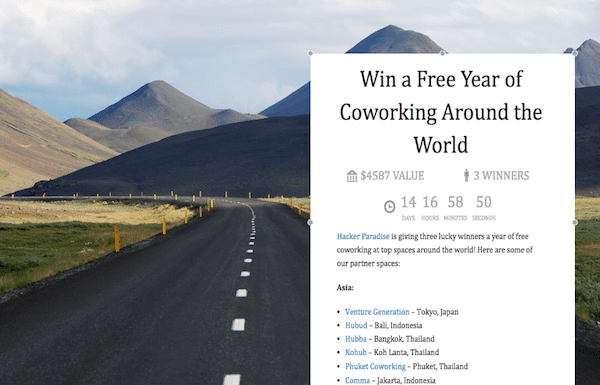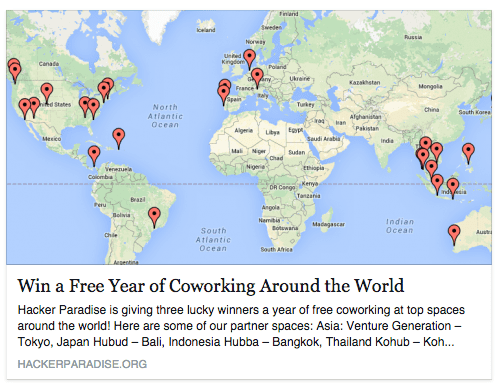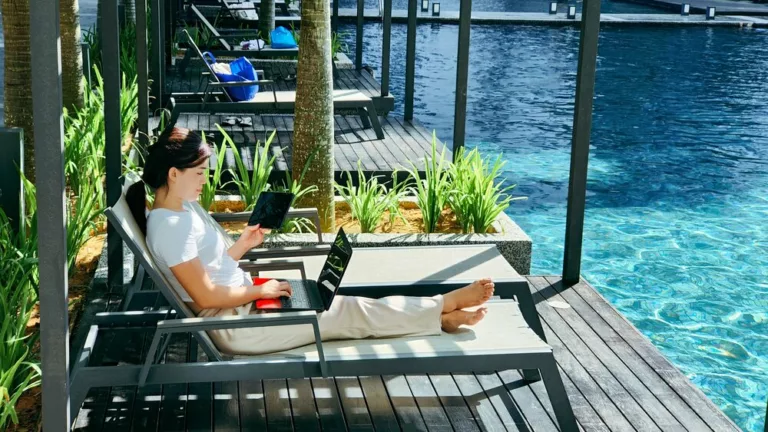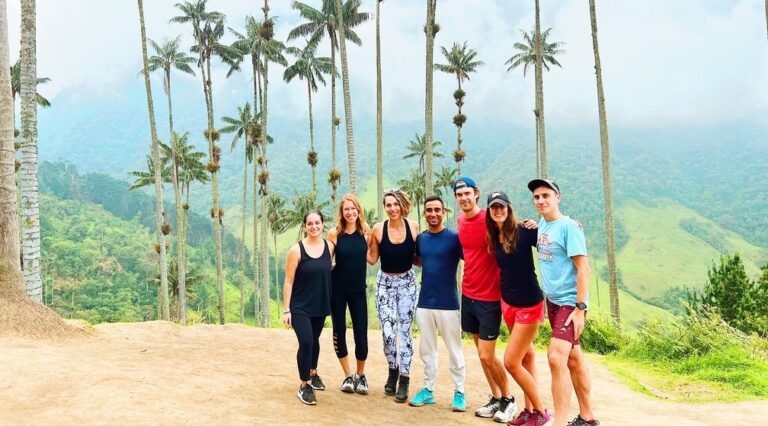What worked, what didn’t, and things that we’ve learned along the way.
In the last 6 months, we’ve grown our mailing list from 500 to 10,000+ subscribers while spending less than $500.
We don’t see many startups talking publicly about the successes and failures of their marketing strategies, so in this post, we want to talk a bit about what worked, what didn’t, and things that we’ve learned along the way.
Here are is a high level overview of the different customer acquisition channels we’ve experimented with:
- Product Hunt – Ryan Hoover Says We’re “Not a Product” – 590 unique visitors
- Hacker News – Our User is Drunk – 3,648 unique visitors
- PR – Our Customers Don’t Read TechCrunch Anymore – 971 unique visitors
- Social Media – Auto-following Actually Seems to Work – 2,318 unique visitors
- Coworking Raffle – Holy $@%^, We Went Viral – 21,273 unique visitors
Each of the above channels drew some traffic to our site, but our raffle was an order of magnitude more successful than our other initiatives. Read on for our takeaways from each.
Product Hunt – 590 unique visitors
“Within a few hours, they’d deleted us from their feed.”
This was a channel that we’d believed to have high potential, but ultimately, it didn’t pan out.
After posting our site to their general submission box a few times without getting Hunted, we realized that there were a number of power users on the site whose links got Hunted automatically without any review.
We made a list of 30+ power users, and found a few people who we had connections to. We reached out to one of them, and he thought what we were doing was cool, so agreed to Hunt our site.
Things started out well. After posting, we started trending almost immediately and they sent out a Tweet promoting us:

However, things quickly turned sour. Within a few hours, they’d deleted us from their feed.
After a few emails back and forth with Ryan Hoover, we were told that we had been deleted for being “outside the scope of a ‘product.’” This was super frustrating, as there weren’t (and I believe, still aren’t) any concrete guidelines for what Product Hunt deems to be a “product.”
Still, not to be discouraged, we decided to make a mini-product, workaway.io, which would be an aggregator of communities like ours. We spent a day or two putting it together, and then asked our same friend to hunt it.
We got deleted in under 10 minutes.
At this point, we realized that it probably wasn’t a good use of our time to continue building things specifically for Product Hunt, and we haven’t really focused on it as a marketing channel since. Still, when people post things that are related to our space, we try to join the conversation and leave comments.
Lessons learned – Product Hunt:
Product Hunt can be a great way to get traffic, but the moderation team can be fickle, so don’t rely upon it. Try to position yourself as a “product” as much as possible, although there are no concrete guidelines for what this means. Engaging in the community seems to be worthwhile, and if you’re having trouble getting Hunted, reach out to power users whose submissions get Hunted automatically.
Hacker News – 3,648 unique visitors
“This… was more than double the traffic we got from TechCrunch and The Guardian combined.”
Hacker News has been a solid source of traffic for us, and we think that we’ve only begun to scratch the surface.
Outside of submitting our own content, we’ve had great success from actively engaging in discussions with the community. On a semi-regular basis, there are posts about travel, digital nomadism, or one of the other players in our emerging space, and we’ve had a number of people apply after interacting with us in the comments section.
Also, one of the largest Hacker News-related sources of traffic has been www.theuserisdrunk.com. One of our participants made this at a hack day during our trip, and when it started trending on Hacker News, we asked him to put a “Made at Hacker Paradise” line at the very bottom.

To make a long story short, The User is Drunk trended at #1 for almost an entire day, bringing him over 120,000 unique visitors. Out of those, over 2,500 clicked through to our site. This alone was more than double the traffic we got from TechCrunch and The Guardian combined (more on that below), and emphasizes how powerful it can be to hit that #1 spot and stay there for an extended period.
Total unique visitors directly from Hacker News: 403
Total unique visitors from The User is Drunk: 2,881
Lessons learned – Hacker News:
Trying to get on the front page of Hacker News is a bit of a gamble, but when it works, it pays off in spades. Keeping an eye out for posts related to your business and interacting with people in the comments is a less impactful but more reliable way to get traffic.
PR – 971 unique visitors
“People are getting less and less news directly from news sites in favor of socially curated sites like Hacker News and Reddit.”


Earlier this year, we were mentioned in a few sentences in a Guardian article on “co-working holidays,” so we reached out to the writer to see if she’d be interested in coming to Bali and checking out our trip in person.
The Guardian sent her and a photographer to join us in Bali for a week to get the full Hacker Paradise experience, and being freelance journalists, the two of them integrated seamlessly into our group. A few weeks after they got back to London, The Guardian published their piece, which turned out great, but didn’t drive a ton of traffic.
Total unique visitors from The Guardian (across both articles): 323
Next, an alumni from our first trip connected us to a TechCrunch contributor who was looking to write something on the phenomena of working & traveling. A week later, we had an interview, and several days after that, we were live on TechCrunch. This article sent us a bit more traffic, but its effects were still quite underwhelming.
Total unique visitors from TechCrunch: 648
One reason we think that the articles didn’t drive a ton of traffic is that fewer people are reading news direct from the source anymore. Instead, they rely upon socially-curated news sites like Hacker News and Reddit.
The fact that a “Made at Hacker Paradise” line at the very bottom of The User is Drunk (which hit #1 on Hacker News) drove over twice the combined traffic of TechCrunch and The Guardian seems to confirm this quite clearly.
Lessons Learned – PR:
It was surprising to us how effective it was to just reach out to a journalist on Twitter who had written about our space. If you’re interested in pursuing PR, you should keep a list of all journalists who have written about related topics and ping them with ideas & opportunities.
Also, people are getting less and less news directly from news sites in favor of aggregators like Hacker News and Reddit. If you’re hoping an article about your company will drive traffic, it needs to be interesting enough to succeed on these social news sites.
That being said, there are still benefits to being covered in the mainstream media, such as the credibility that comes with adding an “As Seen in TechCrunch” or “As Seen in The Guardian” logo to your site.
Social Media – 2,318 unique visitors
“Auto-favoriting and follow marketing actually seem to work.”
There are several things we’ve tried with social media:
- Posting regular pictures from our trips
- Auto-favoriting Tweets about topics related to work & travel
- Following people who follow other Twitter accounts in our space
Social media seems to be surprisingly effective – we’ve had several people who ended up coming on our trips after we favorited one of their Tweets or followed them. Since it’s hard to measure the effects and ROI on our time, we’ve deemphasized this. However, we may experiment with it again in the future.
We also think our regular social media posts are worthwhile. A large number of our applicants come through word of mouth, and we believe that posting photos to Twitter and Facebook helps to tell our story, gives our participants things to share, and shows people what it’s like to join one of our trips. I mean, hell, who wouldn’t want to work here:

(Da Nang, Vietnam)
Total traffic from Twitter (pre-raffle): 664
Total traffic from Facebook (pre-raffle): 1,654
Lessons Learned – Social Media:
Auto-favoriting and follow marketing actually seem to work, although it’s unclear how effective they are in relation to the amount of time invested. Another takeaway from writing this article is that we probably need to get better at measuring the effects of our social media campaigns.
Raffle – 21,273 unique visitors
“We were blown away by how much attention this got.”
This has singlehandedly been the most effective thing we’ve done for marketing in the last 6 months, and has driven exponentially more traffic & signups to the site than any other channel.
It got started when back in March, we did a marketing brainstorm to come up with ways we could raise awareness for Hacker Paradise among remote developers. One idea we had was to throw a hackathon focused on digital nomadism / remote work, and one of the prizes we were thinking of offering was a free year of coworking around the world – one month free at 12 different spaces all over the globe.
That’s when we came up with the idea of doing a raffle. It seemed like a way to attract people to an awesome prize without having to organize a hackathon, which we knew from experience takes a ton of work.
We reached out to a number of coworking spaces, and many of them immediately signed up to be a part of the raffle. Since it doesn’t really cost a coworking space much to have one additional person, most of them treated it as an opportunity for free publicity.
We had 12 spaces on board within a few days, but we wanted a more diverse offering between the US, Europe, and Asia, and so spent another week or so emailing more coworking spaces about the raffle.
In the end, we got 40+ spaces on board, meaning we had enough partners to crown 3 different winners. We bought the KingSumo plugin for running raffles on WordPress, set up everything on a Dreamhost server, and then shipped it:

We were blown away by how much attention this got. We got massive amounts of social shares on Facebook and Twitter, and within the first 24 hours, we had over 1,000 people enter the raffle. The traffic actually kept on overloading our Dreamhost server, so we had to upgrade to a VPS.
We finished the contest on May 3rd with over 10,000 people signed up. To put this in perspective, our mailing list before the raffle was somewhere around 800 subscribers. We also ended up tripling our Twitter followers and quadrupling our Page’s Facebook Likes.
Why was this so successful? We think it was a combination of a few things.
To start, we found an aspirational prize that resonated well with our target market: people who wanted to travel and work at the same time.
It also probably helped that we had 40+ coworking spaces on board at launch, many of whom Tweeted about us or otherwise promoted the contest to their communities. This really helped plant the seeds of virality all over the world.
Another large part of the success is probably due to the sharing mechanics of the KingSumo raffle plugin. It made things super easy: come up with an awesome prize, customize site content & a few emails, then sit back and watch the magic happen.
Also, one interesting finding was that we had significantly more referrals from Facebook than from Twitter during the raffle. One potential explanation for this is that when you shared our link on Facebook, it included a preview with an awesome map graphic:

On Twitter, it only included a simple link:

Total raffle-related Facebook traffic: 20,598
Total raffle-related Twitter traffic: 675
Total number of raffle entrants as of 4/28: 10,048
Lessons Learned – Raffle:
Raffles can be super effective, even if you don’t already have a large mailing list.
Come up with a remarkable prize, and then you can hit the ground running quickly with a turnkey solution like KingSumo or Rafflecopter. If using a tool like KingSumo, make sure you set upload a picture to be included in Facebook shares.
Also, you should think about the prize as another possible way to get distribution for the raffle. Try and find products from companies who will help you get the word out.
Conclusion
We tried a bunch of things over the last 6 months, and found that a well-put-together raffle was the most effective channel for driving traffic, email signups, and applications. We’ll probably follow up with another raffle in another 3-6 months, and will also be putting some time into trying to hit the front page of Hacker News, as we’ve seen that can also be a high-ROI way to acquire users.
One area we haven’t experimented much with yet is word of mouth. While it’s hard to measure how effective marketing initiatives are on word of mouth, it’s already leading to a fair share of our applications, so encouraging more offline sharing could be a high-potential area for us going forward.
If you’re a startup trying to figure out your own marketing strategy, hopefully the above can provide some food for thought and give you some direction.
Do you have some feedback on the above? Have you tried something similar with a different result?
We want to hear from you! Shoot us an email.







